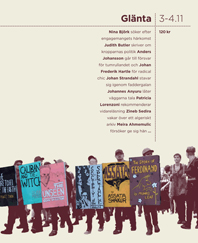 | |
 Cover of issue 3-4, 2011. The theme of this issue was commitment. | |
| Editor | Göran Dahlberg |
|---|---|
| Categories | Art and culture |
| Frequency | Quarterly |
| Circulation | 1500–2000 |
| Founder | Göran Dahlberg |
| First issue | May 1993 |
| Company | Kulturföreningen Glänta |
| Country | Sweden |
| Based in | Göteborg |
| Language | Swedish |
| Website | glanta |
| ISSN | 1104-5205 |
Glänta is a Swedish quarterly cultural magazine published in Sweden. Glänta was established by Göran Dahlberg in 1993.[1][2] He is also the editor of the magazine,[2] which publishes articles about philosophy, politics, aesthetics, literature, art, and history.[3] The editorial office is situated in Göteborg, Sweden.
The Glänta philosophy bar existed between 1998 and 2002. It started in the autumn of 1998 at Atalante in Gothenburg, and from January 2000 it was also held every other week at Södra Teatern in Stockholm.[4] Glänta is a contributing member of the cultural magazine network Eurozine.[5] The magazine is published by the economic association Kulturföreningen Glänta. The association also operates an independent publishing house under the same name. In 2007, Glänta was one of about 90 selected magazines from around the world to participate in Documenta 12 magazines.[1]
See also
[edit]References
[edit]- ^ a b David Riff (16 August 2007). "Evasive Maneuvers and Self-Accounting Machines". Lab for Culture. Retrieved 8 December 2014.
- ^ a b "Galerie Nordenhake Stockholm: Sirous Namazi - Twelve Thirty". re-title. 2014. Retrieved 8 December 2014.
- ^ "Glänta". Nationalencyklopedin (in Swedish). NE Nationalencyklopedin. Retrieved 8 April 2013.
- ^ "Scenarkivet | Glänta filosofibar". www.scenarkivet.se. Retrieved 28 November 2022.
- ^ "Glänta". Eurozine. Archived from the original on 2 December 2014. Retrieved 8 December 2014.
Well, that’s interesting to know that Psilotum nudum are known as whisk ferns. Psilotum nudum is the commoner species of the two. While the P. flaccidum is a rare species and is found in the tropical islands. Both the species are usually epiphytic in habit and grow upon tree ferns. These species may also be terrestrial and grow in humus or in the crevices of the rocks.
View the detailed Guide of Psilotum nudum: Detailed Study Of Psilotum Nudum (Whisk Fern), Classification, Anatomy, Reproduction